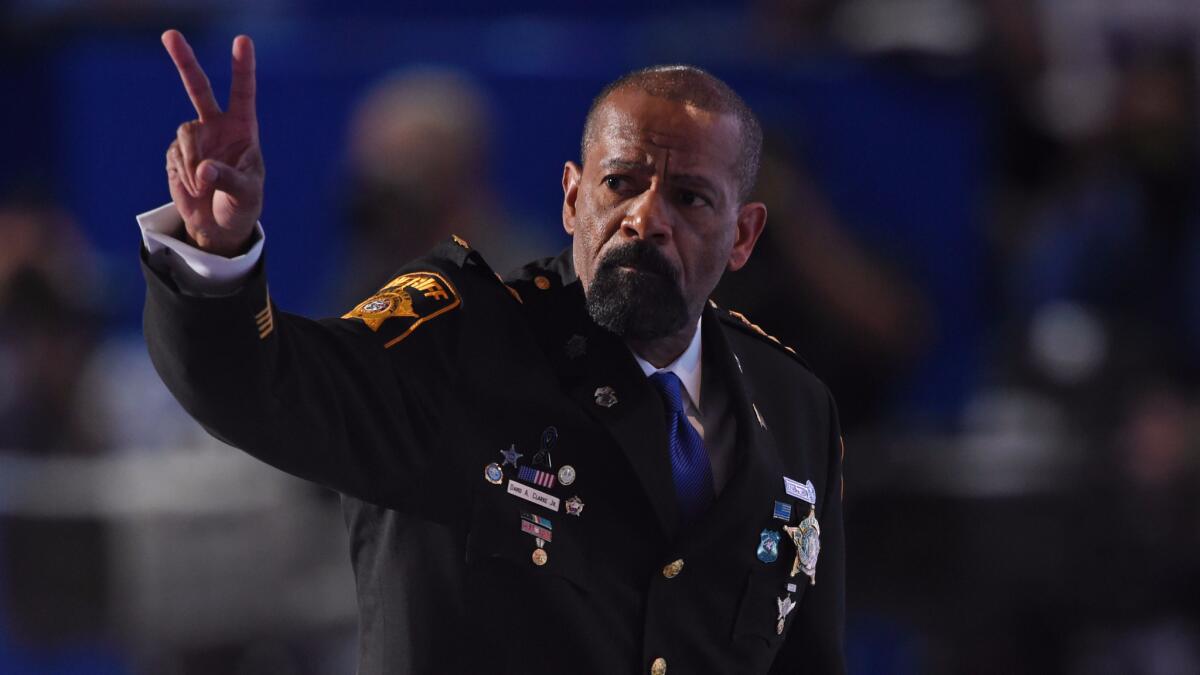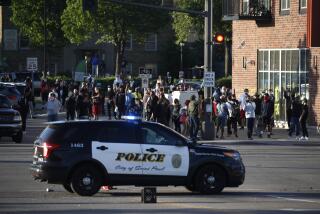Amid Milwaukee unrest, a conservative black sheriff clashes with the city’s liberal white police chief

- Share via
Reporting from Milwaukee — As riots raged in Milwaukee, the county sheriff took to Twitter.
“Black LIES matter,” David Clarke wrote to his quarter-million followers, ridiculing the Black Lives Matter movement.
The protesters, he tweeted later, were part of a “culturally dysfunctional underclass” and were responding to “inane provocation.”
His taunts stood in sharp contrast to the message being sent out by the Milwaukee police chief. Speaking on local television, Edward Flynn laid out the facts of the shooting that had ignited the unrest, then said he was heading to a meeting with local black pastors to plead for their help.
It was “very important that those people that are in the neighborhood are constantly giving a message of peace and civility,” Flynn said. “Nothing is being accomplished through acts of violence.”
In racially charged Milwaukee, the two most prominent law enforcement officials — whose jurisdictions overlap — are proving that race is anything but simple. Clarke is black. Flynn is white.
They have clashed with each other for years over the roots of mistrust between police and black residents and how to quell increasing violence in a city with some of the deepest racial inequalities in the country.
A spike in homicides. Job loss. Bad schools. Milwaukee unrest ‘isn’t about one thing’ »
Clarke, a conservative, argues that downtrodden blacks are largely to blame for their own plight and that “black-on-black violence” is a bigger problem than mistreatment of blacks by police. In turn, he has taken a get-tough, lock-em-up approach to policing, including the use of military equipment.
He has blamed Flynn for increases in violent crime in Milwaukee, saying the city’s police force should hire more officers to crack down harder on crime. Clarke has also encouraged citizens to arm themselves.
Flynn, a liberal, sees the anger of the black residents as a product of poverty and decades of official neglect and believes the biggest gains will come from increased cooperation between officers and the community. He has belittled Clarke’s proposals and argued that allowing people to carry concealed weapons has increased deaths from gun violence.
Their disagreements have come to a head on a national stage this week as Milwaukee grapples with the aftermath of the police killing of a 23-year-old black man, Sylville Smith, a case that itself complicates the narrative that has dominated a national debate over policing and race.
Authorities say Smith had taken off on foot after a traffic stop and turned toward an officer while raising a gun. Mayor Tom Barrett says he has seen a photograph showing that Smith was armed. Smith’s family says he sometimes carried a gun but doubts that he would have raised it at an officer.
He’s not from here.
— Milwaukee County Sheriff David Clarke, on city Police Chief Edward Flynn
The officer who fired the fatal shots was also black, and according to Smith’s family, the two men knew each other from high school.
The state justice department is investigating the shooting and plans to release a video from the body camera of the officer, according to a spokeswoman, though she said there was no timeline for making it public.
In interviews, the two law enforcement leaders had little nice to say about each other.
“He’s not from here,” Clarke said of Flynn, calling him “political” and “arrogant.”
“Nobody has got more to say about law enforcement and less to do with it,” Flynn said of Clarke, calling him a self-serving man who seeks “celebrity.”
Clarke, who describes himself as the “people’s sheriff,” rarely leaves home without his cowboy hat and likes to ride his horse through the city.
A frequent guest on conservative talk shows and a Donald Trump supporter, he was one of five black speakers at the Republican National Convention in Cleveland, where he denounced Black Lives Matter as “anarchy.”
On the day Smith was killed, Clarke tweeted that the reaction was overblown and misguided: “Four murdered, 9 shot in Milwaukee Fri night/Sat morning. Silence. 1 cop kills an ARMED black guy & riots break out?”
The son of an Army paratrooper-turned-postal-worker and a secretary for the city’s public schools, Clarke grew up in one of the two black families in a white community about a 12-minute drive from Sherman Park, the black neighborhood where rioters burned buildings and smashed police cars over the weekend.
He joined the city’s Police Department at 21 and rose through the ranks for more than two decades to become the head of its intelligence division, earning a reputation as being loud and flashy.
Clarke left the city police after the governor appointed him sheriff in 2002 to fill a vacancy. With wide support from the mostly white, mostly Republican Milwaukee suburbs, he has kept the job through four elections.
Now 59, he oversees about 350 deputy sheriffs and 500 corrections officers in a jurisdiction that stretches 1,190 square miles and includes about a million people. His deputies are responsible for patrolling county parks, highways and the airport in the city of Milwaukee. A sheriff would typically oversee everyday policing in unincorporated areas. Milwaukee County has none.
Clarke called poverty a “major issue” in Milwaukee but blamed liberal politicians, social welfare programs and black people for it.
Flynn, in contrast, expressed empathy for blacks who say they are angry about police shootings and living conditions. “The neighborhoods that depend on us the most” and where officers end up the most, he said, “are also the ones that have been the most historically ignored.”
Nobody has got more to say about law enforcement and less to do with it.
— Milwaukee Police Chief Ed Flynn, on county Sheriff David Clarke
The son of a paralyzed World War II veteran and a library worker, Flynn was 23 when he joined the police force in Hillside Township, N.J. He went on to be police chief in several East Coast cities and later served as secretary of public safety in Massachusetts.
He arrived in Milwaukee in 2008 after being recruited by a Democratic-appointed city commission. His responsibilities include street policing, traffic enforcement and responding to crime across the 96-square-mile city of 600,000 people.
The 68-year-old chief pointed to large racial disparities in income and education levels and suggested that such factors, coupled with loosened gun laws, played a role in a rising homicide rate. There were 145 murders in the city last year, a 69% increase over 2014 and the most since 1993.
“If you are a city police chief, you know all racial and social classes commit sin at the same rate…,” he said. “But public violence belongs to the poor.”
While the animosity between Clarke and Flynn has largely been a war of words, it spilled over this week into heated debate over how to respond to the riots.
Clarke asked the governor, Scott Walker, to call in the state’s National Guard. Flynn, who said he was offended he wasn’t consulted, pushed back. He worried that a military presence in the city would increase tensions between protesters and police.
The guard was not deployed, but 123 guard members were in the region this week awaiting commands. On Wednesday, Clarke told the governor to send them home.
Clarke also drew scorn from Flynn for his decision to close a popular county-run park near the protests. Clarke said rioters were using it as a staging area. Flynn said the move alienated the community.
With Flynn’s agreement, Clarke had already sent 100 deputies to the neighborhood, joining 150 city police officers already there.
The differences between the two leaders were evident on Tuesday night. Some of Flynn’s black officers were out chatting with residents who attended a vigil, while Clarke’s deputies patrolled the streets in armored trucks.
Many black residents express disdain for Clarke. Flynn gets better reviews, but he has also faced serious criticism for the deaths of several black men in shootings by his officers or in their custody. The best-known case involves Dontre Hamilton, a 31-year-old mentally ill man who was shot in a park in 2014 by a white officer, who was later fired but not prosecuted. His death has become a rallying point in the Black Lives Matter movement.
As the rioting subsided this week, residents gathered in Sherman Park to mourn and talk with each other about how to improve a neighborhood where conflicts with law enforcement had become common.
Gary Conner, who is 28 and was friends with Smith, said he would start by reducing the police presence.
“This is our neighborhood,” he said. “If we are not causing violence, why are you here bothering us? If there’s none of that, you don’t need to be in the neighborhood.”
Jaweed Kaleem is The Times’ national race and justice correspondent. Follow him on Twitter, Facebook and Instagram.
ALSO
26 overdoses in just hours: A small West Virginia city faces its demons
Baltimore terminates contract with attorney accused of neo-Nazi ties
In Idaho, there’s no insanity defense for accused shooter who says he was fighting aliens
More to Read
Sign up for Essential California
The most important California stories and recommendations in your inbox every morning.
You may occasionally receive promotional content from the Los Angeles Times.











